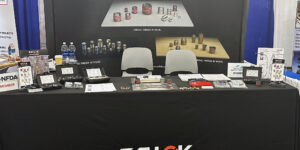ROLL-FORMER/LASER-WELDER IMPROVES PRODUCTION BY 20 PERCENT
Eberspaecher NA operates a unique laser-welding short-tube production cell from Weil Engineering North America that uses Siemens controls and is a showcase of advanced technologies.
Posted: March 12, 2010
Eberspaecher North America (Novi, MI) is a Tier-One supplier of complete exhaust systems. They manufacture stainless steel catalytic converters and exhaust products required by its impressive list of automotive customers, including Chrysler, Dodge, Jeep, Pontiac, Buick, Chevrolet and Mercedes-Benz. Founded in 1865 and in the automotive exhaust business since 1931, this German-based company has operated facilities in the U.S. and Canada since 2000 and currently manufactures in Brighton, MI, as well as Tuscaloosa, AL, and Brampton, ON.
For their new catalytic converter production line, Eberspaecher NA elected to install a laser-welding short-tube production cell. At the heart of this system is a ?Twinmaster? roll-forming and laser-welding production system supplied by Weil Engineering North America (Troy, MI), a subsidiary of Weil Engineering GmbH (Muellheim, Germany). Currently, Weil Engineering has over 60 tube forming and welding systems in operation in North America, most of them using lasers for welding application. Sixty percent of Weil Engineering?s business activities are in the automotive fields, followed by HVAC, chimney, household appliances and motor shell applications.
The Twinmaster combines two major functions in one machine: roll-forming and welding. Secondary processes, such as blank feeding and post-welding expansion of tubes for perfect roundness, are directly linked to the Twinmaster, creating one complete production center. The control functions for the entire system are supplied by Siemens (Elk Grove Village, IL), using a Sinumerik 840D for CNC controls and a Simatic OP170 operator panel for dialog functions. The HMI is configured by Weil Engineering in ?ProTool? for the particular performance requirements of this unique production system.
The production capabilities of this short-tube manufacturing system are:
? Min. and max tube diameter: 3 in to 8 in
? Min. and max. tube length: 8 in to 50 in
? Tube shapes: Round or oval
? Wall thickness range: 0.020 in to 0.080 in
? Materials: Mild and stainless steels
? Output: Up to 500 parts/hour
? Welding speed (3.2 kW laser) 4-5 m/min
The sequence of operation is as follows:
→ Two sheet-metal destackers, mounted on a rotary table, are loaded each with approx. one hour?s production material and feed the blanks into the roll-former. The blanks are inspected for double-sheet condition during the transfer movement. Once the first destacker is empty, the rotary table moves the second destacker into place and the first one can be re-loaded, ensuring a non-stop supply of material.
→ Depending on the length of the tubes, multiple blanks (up to 4) can be rolled into tubes during the same machine cycle.
→ The rolled tube blanks are automatically transferred from the roller to the seam welder, where they are automatically clamped and butt-welded using a laser-beam generated by the Trumpf TLF 3200 laser. (TIG welding is another option for this process, being more economical in cost initially, but also slower in welding speed compared to laser.)
→ Once the welding process is done, the finished cans are extracted from the tooling and transferred onto an inline weld annealing system, which heats the welding zone to approx. 1000 deg C (approximately 1800 deg F) to relieve the stress in the welded seam.
→ After a cooling section, the CNC-controlled handling system introduces the cans into a hydraulically operated tube expander, where they receive a pre-selected inside dimension. This final dimension is calculated from the diameter of the converter substrates, the thickness of the insulation mats and the spring-back of the stainless steel material used for the converter cans.
The sequences of these operations, the exact timing for each process and the control of all movements are monitored and operated by a Siemens Sinumerik 840 D controller. This CNC also monitors the position, the power and the on/off condition of the laser beam, as well as all the transfer mechanisms and the tooling. According to Weil Engineering?s service manager, Matthias Philipp, ?The open architecture and substantial power of the CNC make it possible to easily monitor and control all these various functions. We also produce our own HMI protocols for the CNC and PLC on the operator panel. The Siemens system makes this much easier to accomplish.?
Onboard the Twinmaster, the CNC technology controls eight rotary axes, with the Simodrive 611U drive package on the destacker and chamfering device. Another 611U operates four axes on the expander and handling system. Using the Profibus field bus system, all CNC, PLC, HMI and drive systems can communicate in a more reliable fashion. This permits one CNC program to be written, and then adapted by the machine builders, such as Weil Engineering, to modify their controls based on the particular functionalities of their equipment.
In this case, for example, two analog outputs are utilized for power and sequencing to control ramping, on/off and other parameters of the laser. The laser on the Twinmaster machine has a 200 mm optics bifocal mirror with a constant focal length. When the material thickness changes, the CNC tooling varies the position of the work piece.
– – – – – – – – – – – – – – – – – – – – – – – – – – – – – – – – – – – – – – – – –
Eberspaecher North America, Inc., 2035 Orndorf Drive, Brighton, MI 48116, 810-225-4583, www.eberspaecher.com.
Weil Engineering North America LLC, 1180 Big Beaver Road, Troy, MI 48083, 248-743-1200, www.weil-engineering.com
.
Siemens Industry, Inc., Drives Technologies, Motion Control, 390 Kent Avenue, Elk Grove Village, IL 60007, 847-640-1595, Fax: 847-437-0784, SiemensMTBUMarCom.sea@siemens.com,
www.SiemensCNC.com
.









